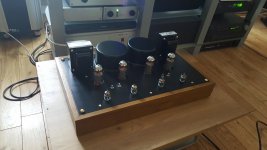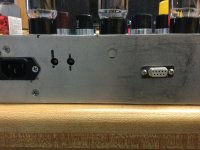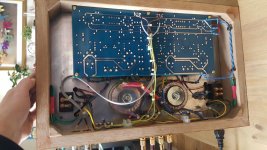I fitted the ground loop breaker this morning and the annoying buzzing seems to have disappeared.
There is still a tiny amount of mains hum but I have to put my ear very near to the speaker in order to hear it.
There is still a tiny amount of mains hum but I have to put my ear very near to the speaker in order to hear it.
Just to re-iterate the PSU requirements for this amp and how I implemented them.
B+ is derived from 320VAC at approx 400mA.
I used two 160VA transformers with their secondaries in series.
0-120V + 0-120V + 0-35V + 0-35V. Under 400mA load these toroids provide 320V.
The heater supplies are 6.3V at 6.5A.
This is a single 50VA toroid with 0-6VAC at 8.5A.
Surprisingly this gives almost exactly 6.3VAC under load.
The cathode bias is derived from 70VAC.
This is a single 50VA toroid 35-0-35V.
This results in about 105VDC but this is OK as discussed previously.
The two B+ toroids are on top of the chassis under the top hat covers.
The other two toroids share the same bolts and are mounted each under one of the B+ toroids.
All these transformers are currently available voltages which gets around having to try to source a rare specialised valve transformer.
B+ is derived from 320VAC at approx 400mA.
I used two 160VA transformers with their secondaries in series.
0-120V + 0-120V + 0-35V + 0-35V. Under 400mA load these toroids provide 320V.
The heater supplies are 6.3V at 6.5A.
This is a single 50VA toroid with 0-6VAC at 8.5A.
Surprisingly this gives almost exactly 6.3VAC under load.
The cathode bias is derived from 70VAC.
This is a single 50VA toroid 35-0-35V.
This results in about 105VDC but this is OK as discussed previously.
The two B+ toroids are on top of the chassis under the top hat covers.
The other two toroids share the same bolts and are mounted each under one of the B+ toroids.
All these transformers are currently available voltages which gets around having to try to source a rare specialised valve transformer.
Last edited:
As Far As I Know, this is probably the easiest kit to source parts for.
The Hammond 1650H OPTs are available from Digikey.
The EL34s and 12AU7s are commonly available.
Just be aware of the issues as discussed with the bias adjustment.
As supplied the PCB allows for the bias to be adjusted into EL34 killing country.
DO USE series 100mA meters when adjusting the bias. I tried measuring across the cathode resistors and, through poor contact, managed to destroy 2 x EL34s.
The Hammond 1650H OPTs are available from Digikey.
The EL34s and 12AU7s are commonly available.
Just be aware of the issues as discussed with the bias adjustment.
As supplied the PCB allows for the bias to be adjusted into EL34 killing country.
DO USE series 100mA meters when adjusting the bias. I tried measuring across the cathode resistors and, through poor contact, managed to destroy 2 x EL34s.
If I were to build this project again I would recommend two differences.
1. I've not found a paint finish that is hard enough to prevent any damage for the upper chassis. This is Smooth Hammerite and it is still very soft and easily damaged. In a second iteration I would consider anodising the finished chassis.
2. The chassis is very heavy. I've only got four fixing points into the Oak frame. It really needs more.
1. I've not found a paint finish that is hard enough to prevent any damage for the upper chassis. This is Smooth Hammerite and it is still very soft and easily damaged. In a second iteration I would consider anodising the finished chassis.
2. The chassis is very heavy. I've only got four fixing points into the Oak frame. It really needs more.
What is really needed to monitor voltage on cathode resistors is a connector on the PCB or chassis. Pig tail plugs in the D connector, universal pin out for all amps I build. Other end goes to gator clips. Some fancy amps use one meter built in and a selector switch. Relying on probe tips is a bad idea in general, as you’ve found out.
Didn’t have any stability issues, did you? And have you measured open loop gain to see which one of us is right (ie, how much voltage it takes for full output with feedback disabled)? And what values did you end up selecting for the feedback resistor and 1st stage degeneration? It will be interesting and informative to know how much feedback you ended up using.
Didn’t have any stability issues, did you? And have you measured open loop gain to see which one of us is right (ie, how much voltage it takes for full output with feedback disabled)? And what values did you end up selecting for the feedback resistor and 1st stage degeneration? It will be interesting and informative to know how much feedback you ended up using.
Attachments
1. I've not found a paint finish that is hard enough to prevent any damage for the upper chassis. This is Smooth Hammerite and it is still very soft and easily damaged. In a second iteration I would consider anodising the finished chassis.
.
Even Duartex comes right off of metal. The only other durable finish other than anodizing would be powder coat. Either way is more expensive than spray paint.
Certainly you could save weight with the transformers. The cathode bias only needs a few miniamps. Having HT and heater separate can be good. Toroidy can make you a transformer to your spec. I don't know if the board can do UL. I try and buy the metal already black. I don't think powder coating is that difficult.
Last edited:
I fitted a break out connector with brass links.
Taken from the star / delta winding connection of a 3 Ph motor.
It's a bit of a pain to take the links out and fit the meters but it is 100% reliable.
Taken from the star / delta winding connection of a 3 Ph motor.
It's a bit of a pain to take the links out and fit the meters but it is 100% reliable.
Mine seems stable as supplied.
I've got a tiny bit of mains hum which is surprising with 540uF of B+ caps.
I've got a tiny bit of mains hum which is surprising with 540uF of B+ caps.
Now I've got to decide which is better and which to keep.
The Pass Aleph J
The Williamson 5-20
My Pass Aleph 4 has already lost the race
The Pass Aleph J
The Williamson 5-20
My Pass Aleph 4 has already lost the race
The mains hum could be caused by h-k leakage in the concertina. The cathode voltage is elevated, probably about 75 volts. With some tubes, that’s enough to make audible hum. I had a 5751 doing that, where the other channel was dead quiet. Stuck in another tube and it quit humming.
As wg_ski suggests there could be a few causes. Do you have a photo of the underside including the input routing. Can you get a trace on a scope of the hum and take a photo.
The Williamson has better bass punch but does have a slightly higher noise floor.
The Aleph J is very similar in sound but is totally quiet.
Both have great headroom and perform well.
The Aleph J is very similar in sound but is totally quiet.
Both have great headroom and perform well.
After a few hours of listening tests between the two, I have to say that The Williamson 5-20 is the better amplifier. It is far crisper and the bass better defined.
The Aleph J sounds muddy in comparison.
I would like to get rid of the low level hum to make it perfect.
The Aleph J sounds muddy in comparison.
I would like to get rid of the low level hum to make it perfect.
Last edited:
- Home
- Amplifiers
- Tubes / Valves
- Building a Williamson EL34 amplifier


